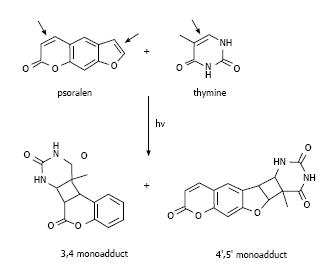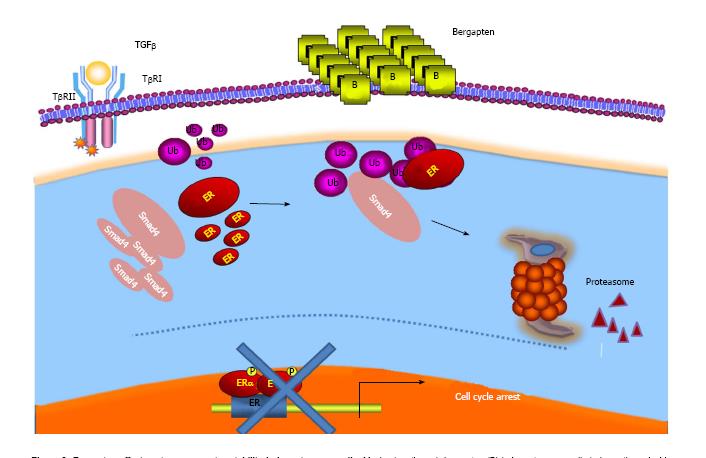Copyright
©2014 Baishideng Publishing Group Inc.
World J Clin Oncol. Aug 10, 2014; 5(3): 348-358
Published online Aug 10, 2014. doi: 10.5306/wjco.v5.i3.348
Published online Aug 10, 2014. doi: 10.5306/wjco.v5.i3.348
Figure 1 Interaction between psoralen and DNA.
Upon absorption of ultraviolet radiation A (UVA) photons, the psoralen excited state can react with a thymine and covalently attach the DNA. The initial photoadduct can absorb a second UVA photon and react with a second thymine on the opposing strand of DNA helix to crosslink the two strands.
Figure 2 Estrogens and growth factor signaling in breast cancer.
Mitogenic signals from estrogens and growth factors activate PI3K/AKT-Ras-Erk pathway to target estrogen receptor (ER). The phosphorylation cascade promotes ER activation. The receptor is recruited to a transcription factor (TF) that binds to responsive elements on DNA for the corresponding transcriptional responses. Antagonistic actions of tamoxifen on ER are shown. Psoralens may act by inhibiting aromatase enzyme, metalloproteinases (MMPs) and CYP enzymes. They address antagonistic effects on PI3K/AKT survival signals and apoptotic response with the involvement of p53 and p21 waf. Estrogens also bind the GPER, a member of the seven-transmembrane G protein-coupled receptor family, to trigger proliferative responses.
Figure 3 Bergapten affects estrogen receptor stability in breast cancer cells.
Mechanism through bergapten (B) in breast cancer cells induces the polyubiquitination (Ub) of estrogen receptor (ER) with the involvement of transforming growth factor-β/SMAD4 protein. Immunoprecipitation assay performed in MCF-7 cells revealed that ER/SMAD4 and polyubiquitin are co-associated. The psoralen enhances the amount of SMAD4 and Poly-Ub complexed to ER, thereby regulating breast cancer cell progression[87].
- Citation: Panno ML, Giordano F. Effects of psoralens as anti-tumoral agents in breast cancer cells. World J Clin Oncol 2014; 5(3): 348-358
- URL: https://www.wjgnet.com/2218-4333/full/v5/i3/348.htm
- DOI: https://dx.doi.org/10.5306/wjco.v5.i3.348











